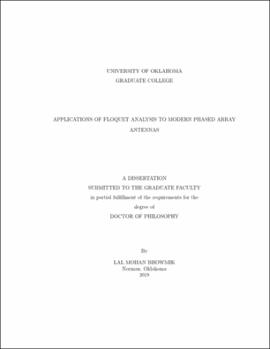| dc.description.abstract | Next generation radar technology is based on phased array technology and provides remarkable scanning flexibility and spatial search capability for the multifunction weather and air surveillance radar systems. The future weather radar is comprised of thousands of antenna elements and requires strict polarization purity, grating lobe free system, low sidelobe levels, suppressed surface waves, low cross-polarization, with beam shape requirements. To address these demands is a serious challenge. Over the past few decades, phased array radar technology has been a tremendous advancement in search for future radar technology. With the blessing of modern computational electromagnetic tools, the theory behind the electromagnetic and circuit-level behavior of large-scale phased array system opened the door to analyze the wide variety of multi-layered, complex system of large arrays. However, numerous challenges still remained unsolved for large scale development. One such challenge in integrating a large phased array is the threat of grating lobes that are introduced by unavoidable disturbances to the periodic structure at the seams between mechanical sub-array modules. In particular, gaps in the ground plane may interrupt the natural currents between elements, leading to radiation from periodic sources that are spaced at regular distances that are typically many wavelengths apart.
In order to quantify these grating lobe effects, an appropriate analysis framework and accurate model are of utmost importance. The model must capture all surface wave and mutual coupling between elements, and the analysis must have a clear formulation that allows for the calculation of worst-case grating lobe levels as well as differences in active reflection as a function of location within a sub-array. To accurately predict those effects, this dissertation work applied a modern method called Floquet framework, coupling with full wave solver to explore the grating lobe effects in infinite arrays of sub-arrays, with each physical sub-array potentially separated from the others by a gap or discontinuity in the ground plane. Calculations are then performed to extract active reflection coefficients and grating lobe levels from the resulting Floquet mode scattering parameters. Additionally, this Floquet framework is expanded from broadside to any scan angles in space. In the mathematical framework, the surface equivalence theorem based on Huygens’s equivalence principle is applied to authenticate its findings. From the simulation results, it is evident that the grating lobe amplitude level emerged to around 30 dB in the E-plane scan and E- plane grating lobes for a patch array. This is due to natural current disruption in between sub-arrays in the ground plane gap and it is very strong in the E-plane, leading to the potential for low-level grating lobe effects. The other planes and scan angles show less significant effects. It was found that the measurements qualitatively follow the simulated results. The Floquet-based method may therefore be used as a good approximation for a worst-case scenario where all gap-based perturbation effects are identical on each sub- array. This can be used for system-level planning to inform a mechanical solution to the electrical connection between sub-arrays.
Another fundamental and paramount challenge for phased array antenna is scan blindness. Scan range of the printed phased arrays is limited by the phenomenon known as scan blindness, which is induced by coherent coupling between the substrate waves/surface waves and the array’s space harmonic fields. Near the scan blindness angle, a phased array system fails to function as a radiator or receiver because of strong excitation of substrate Transverse Electric (TE) and Transverse Magnetic (TM) waves and coupling of desired radiating energy to these unwanted substrate waves. Moreover, this dissertation work, with the aid of Floquet framework, accurately and more precisely captures the surface wave phenomena and its behavior using Electromagnetic Bandgap (EBG) structures to aim to reduce the surface wave excitation in an intelligent way. The reduction of surface waves can be beneficial in several ways to the next generation of digital phased arrays. First, the radiation efficiency will increase due to reduced surface wave excitation. Second, due to decreased surface waves the diffraction from the edges will also be decreased, leading to decreased back radiation and interference with the main pattern in the forward region. Finally, reduction of surface wave excitation ultimately reduces coupling between adjacent antenna elements.
Furthermore, cylindrical radiating phased array radars have a unique challenge. Due to their conformal nature, they support cylindrical surface waves and cylindrical creeping waves. These modes have detrimental effects on the overall pattern quality and lead to “phase mode blindness” like as planar equivalent “scan blindness”. This dissertation seeks to explain, address, and mitigate these surface and creeping wave effects and ultimately suppress “phase mode blindness” using cylindrical EBG structure. | en_US |

